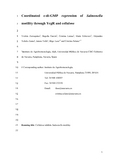Mostrar el registro sencillo del ítem
Coordinated cyclic-di-GMP repression of salmonella motility through YcgR and cellulose
| dc.creator | Zorraquino Salvo, Violeta | es_ES |
| dc.creator | García Martínez, Begoña | es_ES |
| dc.creator | Latasa Osta, Cristina | es_ES |
| dc.creator | Echeverz Sarasúa, Maite | es_ES |
| dc.creator | Toledo Arana, Alejandro | es_ES |
| dc.creator | Valle Turrillas, Jaione | es_ES |
| dc.creator | Lasa Uzcudun, Íñigo | es_ES |
| dc.creator | Solano Goñi, Cristina | es_ES |
| dc.date.accessioned | 2016-11-04T15:31:44Z | |
| dc.date.available | 2016-11-04T15:31:44Z | |
| dc.date.issued | 2013 | |
| dc.identifier.issn | 0021-9193 (Print) | |
| dc.identifier.issn | 1098-5530 (Electronic) | |
| dc.identifier.uri | https://hdl.handle.net/2454/22577 | |
| dc.description | Incluye 1 fichero de datos | es_ES |
| dc.description.abstract | Cyclic di-GMP (c-di-GMP) is a secondary messenger that controls a variety of cellular processes, including the switch between a biofilm and a planktonic bacterial lifestyle. This nucleotide binds to cellular effectors in order to exert its regulatory functions. In Salmonella, two proteins, BcsA and YcgR, both of them containing a c-di-GMP binding PilZ domain, are the only known c-di-GMP receptors. BcsA, upon c-di-GMP binding, synthesizes cellulose, the main exopolysaccharide of the biofilm matrix. YcgR is dedicated to c-di-GMP-dependent inhibition of motility through its interaction with flagellar motor proteins. However, previous evidences indicate that in the absence of YcgR, there is still an additional element that mediates motility impairment under high c-di-GMP levels. Here we have uncovered that cellulose per se is the factor that further promotes inhibition of bacterial motility once high c-di-GMP contents drive the activation of a sessile lifestyle. Inactivation of different genes of the bcsABZC operon, mutation of the conserved residues in the RxxxR motif of the BcsA PilZ domain, or degradation of the cellulose produced by BcsA rescued the motility defect of ΔycgR strains in which high c-di-GMP levels were reached through the overexpression of diguanylate cyclases. High c-di-GMP levels provoked cellulose accumulation around cells that impeded flagellar rotation, probably by means of steric hindrance, without affecting flagellum gene expression, exportation, or assembly. Our results highlight the relevance of cellulose in Salmonella lifestyle switching as an architectural element that is both essential for biofilm development and required, in collaboration with YcgR, for complete motility inhibition. | en |
| dc.description.sponsorship | J.V. was supported by a Ramón y Cajal contract from the Ministerio de Economía y Competitividad, Spain. A JAE predoctoral research contract for V.Z. from the Consejo Superior de Investigaciones Científicas (CSIC, Spain) is gratefully acknowledged. This research was supported by a grant from the Departamento de Salud (Resolución 1312/2010), Gobierno de Navarra, Spain. | en |
| dc.format.mimetype | application/pdf | en |
| dc.format.mimetype | application/zip | en |
| dc.language.iso | eng | en |
| dc.publisher | American Society for Microbiology | en |
| dc.relation.ispartof | Journal of Bacteriology, February 2013, vol. 195, no. 3, 417-428 | en |
| dc.rights | © 2013, American Society for Microbiology. All Rights Reserved. | en |
| dc.rights | © del material complementario: los autores | es_ES |
| dc.subject | Cyclic di-GMP | en |
| dc.subject | Salmonella | en |
| dc.subject | Cellulose | en |
| dc.subject | YcgR | en |
| dc.subject | Motility | en |
| dc.subject | Biofilms | en |
| dc.title | Coordinated cyclic-di-GMP repression of salmonella motility through YcgR and cellulose | en |
| dc.type | Artículo / Artikulua | es |
| dc.type | info:eu-repo/semantics/article | en |
| dc.contributor.department | IdAB. Instituto de Agrobiotecnología / Agrobioteknologiako Institutua | es |
| dc.rights.accessRights | Acceso abierto / Sarbide irekia | es |
| dc.rights.accessRights | info:eu-repo/semantics/openAccess | en |
| dc.identifier.doi | 10.1128/JB.01789-12 | |
| dc.relation.publisherversion | https://dx.doi.org/10.1128/JB.01789-12 | |
| dc.type.version | Versión aceptada / Onetsi den bertsioa | es |
| dc.type.version | info:eu-repo/semantics/acceptedVersion | en |
| dc.contributor.funder | Gobierno de Navarra / Nafarroako Gobernua: 1312/2010 |


